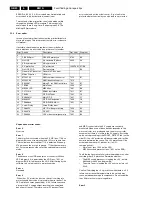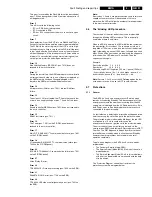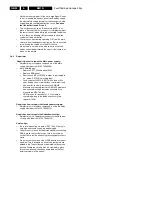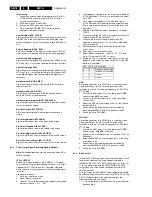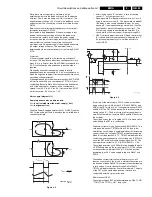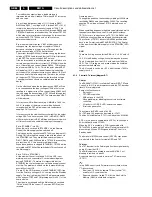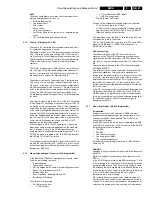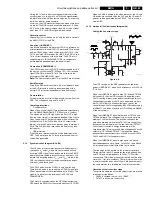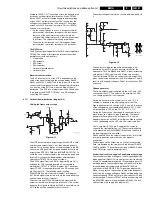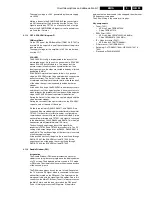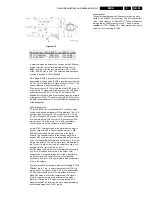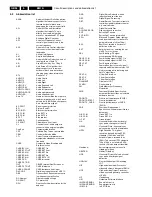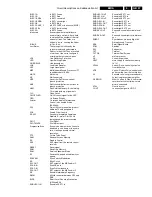
Circuit descriptions and abbreviation list
GB 83
EM1A
9.
The tuner type is a PLL tuner and delivers the IF-signal, via
audio & video SAW-filters, to the HIP (High-end Input
Processor). The HIP has the following functions:
•
IF modulation.
•
Video source- and record select.
•
Colour decoder.
•
Synchronisation.
Two EXT-connectors can be used: AV1 is fully equipped and
AV2 is meant for VCR. There is also a possibility for Y/C in.
The MON-out can be used for WYSIWYR (What You See Is
What You Record).
The HIP delivers the signal to the PICNIC. This IC takes care
of:
•
Analogue to Digital conversion and vice versa.
•
50 to 100 Hz conversion.
•
Panorama mode.
•
Noise reduction.
•
Dynamic contrast.
For
Digital Scan the PROZONIC is required, which can be
connected to the PICNIC.
After the PICNIC the, now doubled, YUV- and H/V-signals
are fed to the HOP (High-end Output Processor). This IC
handles the video control and geometry part. The RGB-
signals from TXT/OSD are also inserted via the HOP. The
video part delivers the RGB signals to the CRT-panel and the
geometry part delivers the H-drive, V-drive and also a drive-
signal for rotation (as a variable DC-level on the V-drive
signal).
Both deflection circuits are 'hot' and located on the LSP and
are driven by the HOP. To make the galvanic separation, the
line drive is driven via transformer 5410 and the framedrive
via optocoupler 7610.The horizontal output stage generates
some supply voltages, the EHT-, focus- and Vg2-voltages.
The RGB amplifiers on the CRT-panel are integrated in one
IC and are supplied with 180 V from the LOT.
The SCAVEM circuit modulates transitions of the Luminance
(Y) signal on the horizontal deflection current, giving a
sharper picture.
The sound part is built around the MSP34xx (Multichannel
Sound Processor) for IF sound detection, sound control and
source selection. Amplification is done via an integrated
power amplifier IC, the TDA2616.
The microprocessor, called Painter (OSD, Teletext and
Control) takes care of the analogue TXT input- and output
processing. The Painter processor and RAM (if present) are
supplied with 3.3 V, which is derived from the +5VSTANDBY.
The NVM (Non Volatile Memory) is used to store the settings,
the Painter is an OTP (One Time Programmable) chip with
programmed ROM-code and the (optional) DRAM is used for
storing the Teletext pages.
In the EM1A there is a separate Standby Supply in order to
reduce the Standby power consumption. During Standby, the
Main Supply is switched off (via TS7529). A relay is used to
switch the Degaussing circuit.
The Main Supply, a SOPS supply based on the 'down-
converter' principle, generates the 141 V (VBAT) and the 28
V for the audio part.
Difference with former MG-sets is that VBAT is not mains
isolated ('hot') and is alignment free.
9.1.3
Power supply (diagram A1 & A2)
General
The power supply has a number of main functions. These
functions are dealt with in succession:
•
Mains filter
•
Degaussing picture tube
•
Standby power supply
•
Main supply
Mains filter (diagram A1)
Figure 9-2
The mains filter has 2 functions: it prevents high-frequency
signals to be transferred into the mains and it protects the set
from lightning damage.
C2507 prevents the high-frequency signals, generated by the
set, to be conveyed into the mains by short-circuiting them.
In case of a lightning surge between the 2 phases (differential
mode) the energy is immediately bled away through the VDR
(R3509) to the other phase.
In case of a lightning surge on both phases of the mains in
relation to the aerial earth, the mains filter acts as a high
resistance (UEMK=L * dI/dt) as a result of which the voltage
across coil L5503/04 increases. A spark gap (0001) prevents
that the voltage increases too much, which would lead to a
damaged coil. When ignited, the current will be discharged
via this spark gap.
The two networks using R3503//0002 and R3502//0003 are
also used for lightning protection. They lead the energy of a
common-mode lightning surge from the 'cold' to the 'hot' side
in case of insertion on the aerial or from the 'hot' to the 'cold'
side in case of insertion via the mains-input.
Resistor R3500 is used for limiting the inrush-current.
Degaussing picture tube (diagram A1)
After switching 'ON' the set via the mains switch, the
DEGAUSS_INPUT signal from the processor (Painter) will
be made high, transistor 7528 will conduct and relay 1002 will
be activated. Initially a considerable current will flow, via PTC
3516, through the degaussing coil. The PTC will heat up,
resistance will rise and the current will decay rapidly. The
Painter will switch off the relay after 12 seconds.
Standby power supply (diagram A2)
This power supply is of a SOPS type (Self-Oscillating Power
Supply) and is regulated by the controlled switching of an
oscillator. It uses the so-called 'Flyback' principle:
Figure 9-3
•
After closing switch 'S', the current ID will increase linear
in time. The magnetic energy in the primary coil is directly
proportional with the self-inductance of the coil and
current ID (thus with the time the switch is closed). The
CL 96532156_019.eps
180100
1
4
2
3
3521
4M7
3509
1R5
3500
5503
3501
6503
6502
6504
6501
GND
+375V
+
220
µ
2510
0001
1501
2507
96532156_020.eps
210100
+
-
-
+
-
-
+
+
RL
D
Id
Uout
C
+
C
+
375V
S
RL
D
Uout
375V
S
Isec


